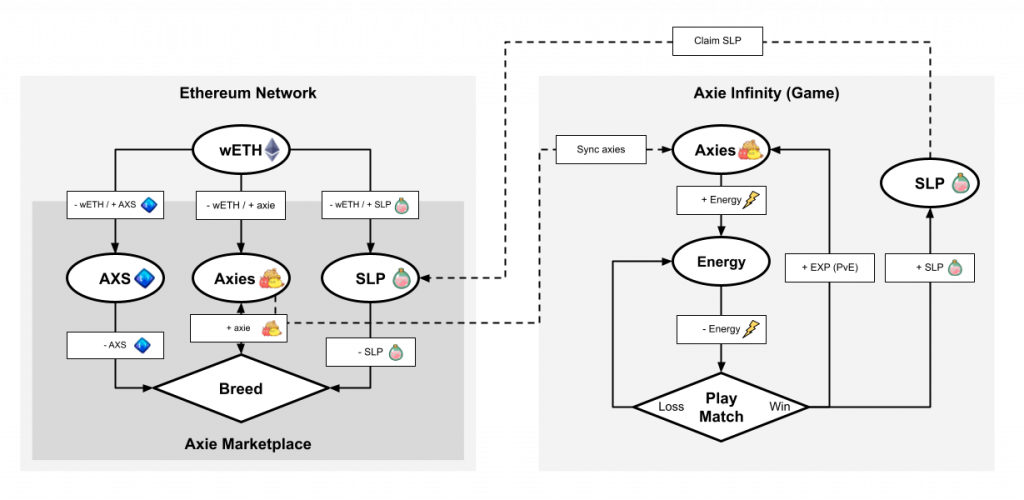Play-to-Earn Gaming and GameFi: Building Blocks of the Metaverse Economy

The recent explosion of interest in the Metaverse has raised the question of how the economy behind this digital universe will take shape. The answer may come from a seemingly unlikely place: video games.
Over the past 20 years or so, video game monetization has evolved from traditional “pay-to-play” (P2P) models to subscription-based and “free-to-play” (F2P) online games. Now, the maturation of blockchain technology—particularly digital assets and non-fungible tokens (NFTs)—has led some pioneering game developers to invent a new monetization model for games called “play-to-earn” (P2E). This, in turn, has given rise to novel economic concepts in the emerging field of “GameFi.”
P2E: Everyone Earns
Video games have long featured virtual assets (e.g., items and coins) that gamers can use to improve or outfit their characters, and more recently can trade with other gamers on virtual commodities markets. For most of gaming history however, those assets did not belong to the gamers—the gaming companies themselves retained ownership.
P2E gaming changes that. In this blockchain-based model, assets that gamers earn by playing a game (or create within the game) are owned by the gamer and can be sold for real-world returns. Assets in P2E games are tokenized as NFTs, which allows gamers to bring them “out” of the game and trade them on central NFT marketplaces or sell them to anyone equipped with a crypto wallet. These assets thus have both intrinsic value within the game and speculative value within the Metaverse economy, so they can fetch a hefty price—for example, one set of seven NFT cards for the P2E soccer game Sorare is currently listed at over $3000. Some P2E games, including Sorare, may also reward players in cryptocurrencies like Ether.
Though still in its infancy, P2E gaming is growing rapidly: between August 2020 and July 2021, the weekly users of blockchain games increased from a few thousand to more than 5 million. Today's most popular P2E games include Axie Infinity, a creature trading and battling game like Pokémon; The Sandbox, a world-building game that is central to the early Metaverse; and Sorare.
Thus far, successful P2E games tend to include:
- A complex, multiplayer universe that rewards users for playing or contributing
- Representation of in-game assets as NFTs to allow for true ownership
- Open marketplaces on which these assets can be traded, in-game and/or on third-party platforms
P2E thus brings the "ownership economy" fostered by the adoption of blockchain into the realm of gaming: rather than building a complete game and selling it to gamers, P2E game developers define a universe then share ownership of it with gamers and other contributors in the community. This is a key outcome of P2E, as it creates joint incentives for both developers and participants to ensure the game’s success and continued development.
Though small, independent game developers have led the charge into P2E gaming thus far, bigger names like Ubisoft are beginning to move into the space as well. These large studios will be pivotal to the growth of P2E gaming, as they have the experience and budgets to build uniquely immersive gaming experiences and they own most of the most popular game franchises. Venture firms have also seized on the space, with Sorare alone raising $680MM last year at a $4.3B valuation.
This astronomical growth is due in large part to the new economic system arising around P2E games: GameFi.
GameFi: Economics of a Virtual Universe
The uniquely collaborative, cooperative nature of P2E gaming has led to some revolutionary new economic concepts collectively known as GameFi (a portmanteau of “Gaming” and “DeFi,” or Decentralized Finance).
Many of these concepts focus on how gamers can earn income from P2E games. For example, a cottage industry of “scholarships” has cropped up around Axie Infinity. Axie scholarships allow the owners of expensive in-game assets (e.g., the Axie creatures themselves) to lend them to other gamers, called “scholars.” Scholars can then play the game using one of their manager's Axies and split any revenue they earn with their manager. Axie scholarships thus allow gamers who cannot afford to buy their own Axies to earn real living wages by playing the game, making them particularly popular in low-income countries like the Philippines. (Though, unfortunately, the blockchain powering the Axie Infinity ecosystem was the victim of a recent hack, the network is back online and Axie Infinity developer Sky Mavis has pledged to recover the lost funds.)
World-building games like The Sandbox also allow gamers to create items and sell them on the open marketplace, and will soon let them lease out the virtual “land” they own. Some digital artists have even made Sandbox item creation their full-time job—demonstrating GameFi’s vast and largely untapped potential to generate new sources of income for many around the world.

Axie Infinity’s GameFi economy. Source: Department of Play
Challenges to P2E/GameFi Growth
As core pillars of the Metaverse economy, P2E and GameFi face many of the same challenges confronting the rest of the blockchain ecosystem. These include:
- Cost – Rampant speculation on blockchain assets has driven up the starting capital needed to play many P2E games: Axie Infinity costs anywhere from $60-1000 (hence the need for scholarships), while Sorare costs around $100.
- User Experience – P2E games often involve a lot of friction at the outset: players must open a crypto wallet, buy cryptocurrency, use that crypto to buy the necessary digital assets, etc. To reach mass adoption, these games will need to reduce onboarding friction and find ways to abstract complex processes behind simpler user interfaces.
- Gameplay – Most P2E games feature basic gameplay mechanics, simplistic graphics, and little storytelling—as of now, they are more experiments with new monetization models and asset classes than they are fun, engaging games.
-
Security – As the Axie Infinity hack demonstrates, this
nascent ecosystem is still subject to significant security risks. As these
companies grow, they will also have to discover and implement robust
security best practices in order to safeguard their users’ funds.
- Regulation and Taxation – Blockchain-based games are by nature global and currently subject to little regulation, but might eventually need to account for local gambling laws, securities regulation, etc. and may even trigger taxable events for each transaction.
- Interoperability – Most P2E games are built on the Ethereum blockchain (and its “layer 2” scaling solutions), making trading assets for those games streamlined. That is not the case for games built on other blockchains—as the blockchain ecosystem grows, this could lead to major interoperability problems.
In order for P2E/GameFi to truly take root, game developers and users will need to find the “sweet spot” between mass appeal and long-term business model sustainability. Furthermore, in-game financial transactions will need to evolve from their current state (mainly leveraging web-based text forms) to something more organic to the Metaverse—e.g., one gamer’s avatar handing their assets to another and sealing the transaction with a hand gesture, while the change of ownership and any necessary verification/KYC needs are handled programmatically in the background and recorded on a blockchain.
As P2E gaming continues to grow in popularity and more established developers get involved, these evolutions should happen quickly. Greater adoption of immersive gaming technologies like VR and AR should improve the gaming experience as well, driving up the value of assets acquired in these digital worlds. This could make P2E and GameFi a space rife with potential for financial institutions within the next several years.
Gaming: A Key Strategic Opportunity for the Financial Industry
The global gaming market topped $175B in sales in 2020, making it the world’s largest entertainment market. Though P2E gaming currently makes up a small fraction of that market, it presents several new opportunities for financial institutions, including: supplying digital wallets to gamers; providing custody of digital goods; offering institutional banking services to in-game groups, guilds, and digital corporations; and helping integrate NFTs into the traditional financial system. Financial firms that are able to support this new asset class in a secure and regulated environment could become major channels for on- and off-ramping value into virtual economies.
Opportunities may also arise to bridge the game developers and other entities at the heart of these virtual economies back to traditional financial products and services. Combining traditional loans, credit lines, and mortgages with new digital asset classes could create significant value—for example, by allowing gamers to put up their digital items as collateral to finance real-world purchases, as our world and the Metaverse slowly merge into a single reality.
For more of Citi Ventures’ thought leadership on blockchain, digital assets, and the Metaverse, click here.
